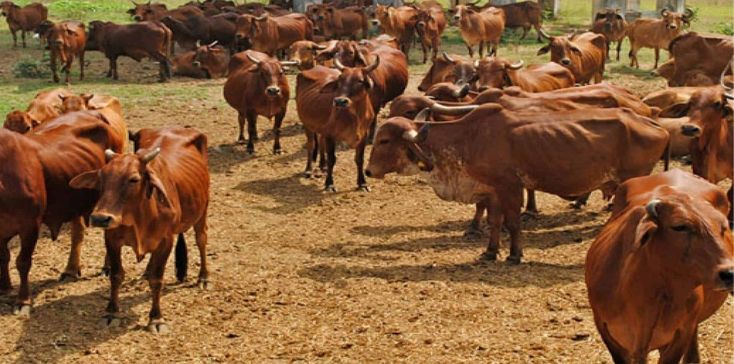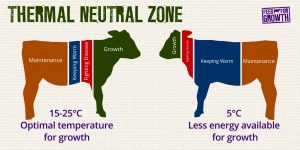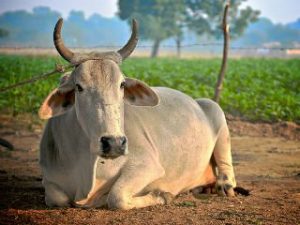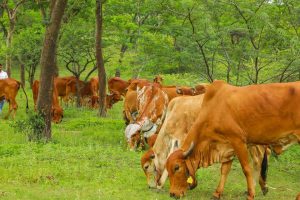
Management of Dairy Cows During Cold Stress
When temperatures start to decline in winter, particularly as we get closer to 5° C, it is time to think about what effect this (cold stress) is having on cow productivity and efficiency.
Like all mammals, cows are warm-blooded and need to maintain a constant core body temperature. The normal rectal temperature for a cow is around 38°C (101°F).
Within a range of environmental temperatures called the “thermoneutral zone,” animals do not have to expend any extra energy to maintain their body temperature. At the lower end of this range, normal metabolic processes supply enough heat to maintain body core temperature. Within their thermoneutral zone, animals may modify their behavior, such as seeking shelter from wind and respond over the long term by growing a thick hair coat for winter, without affecting their nutrient requirements. However, below the lower limit of the thermoneutral zone, in the “lower critical temperature,” the animal experiences cold stress. To combat cold stress, the animal must increase its metabolic rate to supply more body heat. This increases dietary requirements, particularly for energy.

Cattle, like humans, actually experience the “effective temperature,” which takes into account both air temperature and the effect of wind chill. Cool or cold wind passing over an animal draws heat away from it much more quickly than still air at the same temperature. Wind chill effects for cattle are shown in Table 2, below. These figures assume a dry, clean hair coat. If the animal is wet and/or dirty, consider the data to be an underestimation of the effect of the wind.
Cold Stress Increases Energy Requirements.
Some many factors and conditions can contribute to cold stress events in livestock including:
• Wet environments
• Low temperatures
• Wind
• Lack of shelter
Acting independently or in concert with one another, these cold stress contributions can impact cows in several ways including:
• Altering behavior
• Reducing body condition
• Increasing nutrient requirements
• Contributing to lower feed and water intakes
• Compromising performance
Cold stress can negatively affect dry matter intake (DMI). Decreased DMI coupled with increased energy requirements necessary to maintain basal body temperature, work in opposing directions can negatively impact gut health and production parameters. Energy requirements for both body weight maintenance and production demands add to dietary energy requirements (up to 40% more during extreme cold) and create a necessity for higher feed intake. Therefore, any interruptions in feed intake can adversely affect production along with body condition.
During cold stress events, additional dietary energy is required for
• Bodyweight maintenance
• Production demands
• Meeting increased metabolic requirements
Dietary reformulation may be necessary to minimize economic losses during periods of intense cold.
Effect of Cold Stress on Body Condition Score
Body condition score (BCS) is a subjective measure used to indirectly estimate body fat percentage. Fat possesses insulative properties and thereby can be a predictor of susceptibility to cold stress.
Transitioning dairy cows, in particular, will rapidly metabolize fat tissue to support milk production and are most susceptible to cold stress challenges. Interestingly, even fat deposits from the digital footpad (responsible for cushioning body weight when walking or standing) are also mobilized during the transition period. As such, sore feet can reduce the cow’s willingness or ability to access the feed, resulting in reduced intakes and potentially contributing to other health-related challenges.
Cows with low body condition scores can also have more difficulty with the following:
• Calving
• Lower colostrum quality
• Longer recovery
• Poor bred back
Furthermore, calves born from cows with a lower BCS are more apt to be weak at birth and more susceptible to disease due in part to the aforementioned decreased colostrum quality.
Cows with a higher BCS are less severely impacted by cold stress. While body fat is the primary insulating element, thick, dry hair, coat allows heat to be trapped creating an insulative blanket. When the hairs become wet they mat and tend to lie flat allowing the heat to escape, thereby increasing animal susceptibility to cold stress. Wetness and wind should be avoided by providing shelter and windbreaks where cows can find relief. Clean, dry bedding also helps insulate cows from the frozen ground.

Nutrient Enriched Water can Help
During the hot and dry summer months, it is easy to imagine cows requiring abundant water intake. However, even in the cold of winter contributing factors to dehydration include:
• Respiration
• Evaporation
• Urination
Along with high-quality, energy-dense feedstuffs, it is essential to offer cows clean, freshwater 2-3 times daily and ensure it is thawed at all times. Adding minerals and multivitamins to either the feed or water helps support energy requirements and also helps maintain essential electrolyte nutrition necessary for optimized hydration.
Temperature extremes – whether hot or cold – can reduce milk production and general cow health and performance. Good management, solid nutrition, and proper hydration status are critical for optimum outcomes.
Factors Affecting an Animal’s Ability to Withstand the Cold
• Acclimation: Cattle do adjust or acclimate to colder weather by growing a longer, thicker coat. This provides additional insulation against cold weather. The coat must be clean and dry to provide maximum protection to the cow. Dirt or moisture on the coat reduces its insulation value dramatically.
• Fat Layer: Cattle in good condition with a thick fat layer is better able to withstand the cold than thin cattle. The fat layer acts as another insulating layer between the animal’s core and the environment.
• Metabolic Rate: Cows will also increase their metabolic rate to increase heat production and help maintain body temperature. This increases the need for dietary energy, so appetite is usually increased and cows eat more.
The Effects of Severe Cold Stress on Cattle
Hypothermia occurs when the body temperature drops well below normal. In general terms, with cattle, mild hypothermia occurs with a body temperature of 30°C–32°C, (86°F–89°F), moderate hypothermia at 22°F–29°C, (71°F–85°F) and severe hypothermia below 20°C (68°F). As the rectal temperature drops below 28°C (82°F), cows are not able to return to normal temperature without assistance through warming and the administration of warm fluids. As hypothermia progresses, metabolic and physiological processes slow down, and blood is diverted from the extremities to protect the vital organs. Teats, ears, and testes are prone to frostbite. In extremes, respiration and heart rate drop, animals lose consciousness and die.
In most situations, a more insidious and costly problem occurs. Cows are subjected to an environmental temperature below the lower critical temperature, but without obvious signs of hypothermia. This increases the maintenance energy requirement of these animals as they adjust to the conditions and divert more energy to maintain body temperature.
There are two potential responses to this situation.
1. Cows have access to higher quality feed and/or increased intake, and therefore maintain their body weight.
Cows try to increase feed intake to meet their energy requirements. Given the opportunity and gut capacity, cows will eat more feed to help meet their increased energy demands. Practically, it is usually expedient to feed grain as well. These increases feed costs, increasing the cost of keeping cows, however, the expectation is that cows will maintain their body weight!
It is generally accepted that for every 1°C drop below the lower critical temperature, there is an approximately 2% increase in energy requirements. The amounts of additional feed required for a cow under cold stress can be calculated, but as a rule of thumb, a cow with a dry winter coat should be fed the additional feed as presented in Table 3, below.
Table 3. Effective Temperature and the Additional Feed
Required to Meet the Cow’s Energy Requirements
1. Cows may not be able to eat the amount of extra hay required to maintain their body weight and may have to be fed the indicated amount of grain instead of additional hay to meet their energy requirements.
2. Cows don’t have increased feed quality and intake and lose body weight.
If cows are not fed additional feed or the quality does not allow them to eat enough to meet their additional energy requirements, body mass will be “burned” to produce metabolic heat. These cows lose weight as both feed energy and stored fat are diverted to maintain body temperature and vital functions. Cows in this situation that start to lose weight soon enter a downward spiral — the more weight (fat) they lose, the less insulation they have, the more susceptible they are to further cold stress, and they lose weight even faster.
Cows, and especially heifers that lose weight, calve in poor condition. The consequences are increased calving difficulties, an increase in the number of lighter, weak calves, and higher calf mortality. These dams produce a reduced amount of colostrum (of lower quality) and have lower milk production, increased neonatal mortality, and reduced growth rate in surviving calves. These cows usually have delayed return to estrus, longer days open, and poorer reproductive success.

Key management factors to limit the effects of cold stress
• Monitor the weather. Monitor temperature and increase feeding in response to cold weather. Cows in the last trimester require additional grain feeding during periods when the effective temperature falls below the lower critical level.
• Protect animals from the wind. Wind markedly reduces the effective temperature, increasing cold stress on animals.
• Bed cows well. Providing adequate dry bedding makes a significant difference in the ability of cattle to withstand cold stress.
• Keep cows clean and dry. Wet coats have greatly reduced insulating properties and make cows more susceptible to cold stress. Mud-caked coats also reduce the insulating properties of the hair.
• Provide additional feed. Feed more hay and grain. If wet feeds are fed, make sure they are not frozen.
• Provide water. Make sure cows have ample water available at all times. Limiting water will limit feed intake and make it more difficult for cows to meet their energy requirements. Frozen troughs and excessively cold water seriously limit water intake.
We can’t control the weather but we can do everything reasonably possible to reduce the effects of cold on cows. This will help reduce costs and improve production efficiency.
The Effects of Cold Stress on Cattle
When temperatures begin to drop into the single digits, farmers should stop to think about the effect that severe cold weather will have on herd health. The bovine can be very tolerant of cold temperatures. The cow that has a good winter hair coat, adequate body condition, and readily available feed and water can withstand cold extremes that would be fatal to a human. However, even if the cow temporarily withstands these extremes she will pay a price. The price can range from loss of body condition to death from hypothermia.
What is hypothermia?
Hypothermia is defined as the lowering of body core temperature below normal values. Mild hypothermia would occur when the body temperature is in the range of 86-89 degrees Fahrenheit. Moderate hypothermia occurs at 71-85 degrees, and profound hypothermia occurs under 50 degrees. At a rectal temperature under 82 degrees, the bovine can no longer return to normal temperature without external heat and warmed fluid therapy.
The environmental temperature at which the cow will begin to experience hypothermia will vary. Short hair coats, high winds, and wet cattle will amplify the actual environmental temperature and induce hypothermia sooner. As hypothermia sets in, all metabolic and physiologic processes begin to slow. Blood is shunted away from the extremities in an attempt to protect vital organs. Frostbite of the teats and ear tips will occur at this stage. As hypothermia progresses, respiration rate and heart rate decrease and blood pressure drop. Eventually, the cow loses consciousness and death is imminent if rewarming does not occur.
In most cases, if windbreaks and adequate nutrition are provided, hypothermia can be avoided. However, additional health problems should be considered in the winter. Cattle are good weather predictors and will change eating habits before a large storm. Research has shown that cattle will increase grazing activity before a storm, ingest little feed during the storm, and increase grazing activity after the storm. If the cattle are on high-quality pasture, this will increase the chances of bloat.
Make sure that water is available. If water is not supplied, cattle will reduce feed intake. Also, water deprivation followed by intake of saline water or feed containing salt can lead to salt poisoning. Salt poisoning occurs after the water troughs freeze and the animals become dehydrated. When the troughs thaw, the cattle ingest large quantities of water. If the water has a high saline content or the cattle take in free-choice mineral salt, poisoning can occur. Cattle with salt poisoning will have diarrhea and abdominal pain and will refuse to eat. Often they will be blind or staggering with a characteristic knuckling of the fetlock. Most of these cattle will die even after freshwater is supplied.
If the winter is exceptionally hard, the pregnant animals may spend all winter using energy to generate heat. If nutrients are shunted to heat production, cattle begin to lose body condition. Cows, and particularly heifers, in poor body condition, are at risk for calving problems. Also, these animals may provide inferior colostrum for the calf, and neonatal mortality may increase. Besides, these animals do not cycle on time and delay breeding in the spring and summer. Monitor body condition scores throughout the winter and be prepared to supplement the ration with increased energy, protein, vitamins, and minerals when the cattle are exposed to cold temperatures for extended periods. Adult functioning ruminants will survive long periods of cold but may pay the price at calving or rebreeding.
What about the calf?
The calf has a very little fat reserve, is born with a wet hair coat, and does not have the benefit of a functioning rumen to generate heat. Calves can go through the stages of hypothermia quickly and if rewarming does not occur death cannot be avoided. Cows expected to calve in extreme weather must be given shelter or be under constant surveillance to prevent calf loss from hypothermia.
What are some other management strategies that can be used to combat cold weather and limit the effects of cold stress on cattle?
There are several more strategies you will need to know to help your animals in cold conditions:
1. Monitor weather conditions and act accordingly. Monitor temperature changes so you can have more feed available to cattle in colder weather conditions.
2. Ensure there is enough shelter from the wind. Effects of cold stress increase when wind speed increases. Any kind of available protection, whether it is natural (bush, valley bottoms, or hillsides) or man-made (such as simple windbreak fences or shelters) can be highly valuable in helping cows cope with extreme temperatures and wind-chill effects.
3. Provide bedding to help keep cattle clean and dry. Bedding, such as barley straw, will make a significant difference in how cattle can withstand cold stress. Provide enough so that all animals have access, and so that it is about a foot thick, or thick enough animals can lay comfortably. Depending on weather conditions, bedding may need to be added every two to three days; sooner if a significant amount of snow fell soon after bedding was spread out. Cattle will experience a 25 percent energy loss if they are lying on the snow.
4. Provide additional feed. Increase grain and hay for when temperatures drop below the lower critical threshold level.
5. Feed later in the day or evening. Incremental heat production (energy from feed available to produce heat and keep the animal warm) peaks at 6 to 8 hours after cattle eat. Feeding in the late afternoon or early evening provides additional warmth from fermentation activity in the early morning (or around 4 to 6 a.m.) when temperatures are at their lowest. This makes for better use of your feed supplies and meets your animals’ higher energy requirements at a time when it is most needed.
6. Provide water. Make sure animals have ample water available at all times. A limit in water available will limit feed intake and make it more difficult for cattle to meet their energy requirements. excessively cold water can severely limit water intake.
7. Sort off thin cows for more specialized care. Sorting off thinner cows from the rest of the herd allows you to feed them differently and eliminate competition from bigger and bolder cattle. Thinner cows need more energy to cope with colder conditions, and will also have higher nutrient demands when they get ever closer to calving and into lactation. Separating them from the bigger cows allows them the chance of gaining weight, and even gives the bigger, fatter cows the ability to lose excess or maintain weight. This, overall, will make the best use of existing feed inventories.
Cold weather conditions can create a challenge for cattle. Balanced feed formulations developed for cows in mild or warm conditions will be unsuitable when those animals experience cold weather or cold stress; weight loss and reduced performance can result. Animals undergoing cold stress require more energy and feed to maintain body condition and body temperature, as well as performance in terms of growth, gestation, and lactation.
How does the cold weather affect a lactating cow’s energy requirements?
Normally, in mild and warm weather conditions, lactating cows require about 25 to 30% more energy than when they are in gestation. In colder weather conditions this differential is greater, with lactating cows requiring 40 to 60% more energy than if they were dry and pregnant. Lactating cows in these cold conditions need additional energy because they have to maintain their body condition and produce milk for their calf while withstanding the cold. They increase more so when cold conditions dip below their lower critical threshold levels and especially when the wind picks up.
What other factors affect a cow’s energy requirements in cold weather?
Acclimatization is important because cattle that are raised primarily indoors where the temperature is controlled are more likely to become cold-stressed than cattle that are raised outdoors all year round; this is because they have not been able to grow thicker hair coat in response to increasingly cooler temperatures.
Metabolic rates tend to increase as well when the weather gets colder; this is a way for the cow to increase heat production to maintain body temperature. When metabolic rates increase, there is a greater need for dietary energy, as well as a rise in daily feed intake.
Hair condition will also affect the energy requirements of cattle; Cows that have mud-caked or wet coats will have higher energy requirements because the insulating properties of a winter coat will be greatly reduced, making them more susceptible to cold stress.
How does a cow’s intake level change during cold weather?
For a cow in normal body condition (BCS 3) with a dry, clean winter coat, dry matter intake levels can increase from 5 to 30% or more. This is because a cow’s metabolic rate has increased in response to colder conditions. An increased metabolic rate increases a cow’s appetite, which in turn increases the rate of passage of feed. This is an adaptive response to colder conditions; cows can increase internal heat production via rumen activity or fermentation, which decreases their risk of cold stress. An increase in a cow’s internal heat production reduces her lower critical threshold temperature.
Some cold weather conditions, like severe winter storms with high winds, can suppress intake because cattle are more concerned with trying to stay warm than eating. Wet and matted hair coats or cattle covered in wet snow or mud can also suppress intake because of the cold stress they are experiencing.
Can cows digest feed more efficiently in cold weather?
The efficiency of digestion is reduced with cold weather and cold stress. This is mainly because the rate of intake has increased. When cattle eat more, the feed spends less time in the first two stomach chambers (reticulum and rumen) and passes through more quickly. Nutrients are more likely to escape microbial breakdown, making them more available to the cow. Protein can be reduced during cold events because of this, particularly when more protein is available for absorption in the small intestine.
